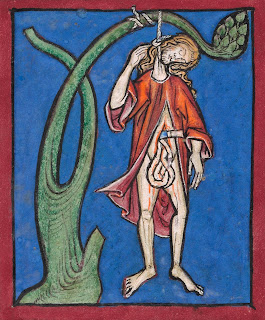After re-evaluating Joe Simon's BROTHER POWER issues here, I occasionally contemplated checking out Simon's 1960s magazine SICK. I never read it in The Day, but its first incarnation enjoyed some duration, presumably providing Simon with his daily bread for the decade. I picked up a back issue at random, and found that the issue was modestly entertaining, evincing a darker sense of humor than the MAD of the 1960s.
Humor magazines didn't get a lot of fan-coverage over the years, and similarly, not many online fans have labored to scan issues of old humor mags, and so this essay will be almost image-free, like my analysis of THE MAIDEN AND THE DRAGON. However, "Giant Killer" is only one page, consisting of five panels, so it's not that hard to describe. SICK didn't provide credits in their contents-page, and the signature on the piece is difficult to make out, so based on other info I'm tentatively crediting the work to SICK contributor Arnoldo Franchione. In the unlikely event that someone corrects me, I'll issue a retraction. (Hah.)
PANEL 1: The "Giant Killer" of the title is the Biblical David, seen at the moment of his first heroic act, at the moment that he slays the hulking warrior Goliath with a stone from his sling. No one else is seen but the two combatants. Goliath looks to be over ten feet tall and is bearded; David is a beardless youth with something of a Dudley Do-Right profile.
PANEL 2: The colossal feet of dead Goliath are seen at right, and out of nowhere a bunch of identical, black-bearded figures appear to acclaim David. Though the context would suggest that they are Israelites, they look like the stereotype of the Arab, since all of them wear the traditional burnoose and thawb (robe) that mark said stereotype. Here's an approximation of the visual stereotype, taken via Google from a news-story on a controversial high school mascot.
PANEL 3: The burnoosed men, all smiling toothy smiles, take David upon their shoulders. He seems genially pleased with their attention.
PANEL 4: The maybe-Jews start walking, carrying David along, as he raises his arms over his head in a "aren't I great" gesture. He doesn't notice that the group is approaching a palm tree.
PANEL 5: At left David is now dead, hanging by the neck from the palm tree, and the maybe-Jews are walking away in triumph.
Now, the obvious "lateral meaning" here could be boiled to, "One day you're a hero, the next you're a blood sacrifice." And if Franohione had chosen to make his ironic point with, say, a historical figure like Julius Caesar, maybe that would be all there would be to it.
But because Franchoine chose to invoke the myth-story of the Israelite king David, this means that this one-page cartoon reaches into a different set of references. In my essay NARRATIVE AND SIGNIFICANT DISCOURSES I noted how some myth-works may "structure [a] narrative... as a commentary on other narratives"-- the narrative in this case being the grand scheme of patrilineal descent that ties King David to Jesus of Nazareth (however tortuously).
In the Old Testament, of course, David does not get sacrificed. The very popularity he gains from killing Goliath endangers his life, when current monarch Saul tries to eliminate the competition. But David lives to a ripe old age, and his passing has nothing to do with hanging-- though images of hanging play a definite role in the fate of the House of David.
Long after David has become king, one of his sons, Absalom, attempts to stage a coup and become the new ruler. The rebellion fails. Absalom flees, but he's captured and killed after his long hair gets caught in a tree's branches, pulling him from his steed.
Much later, Jesus of Nazareth suffers a death that involves an image of hanging, albeit not by the neck.
Finally, contemporaneous with the death of Jesus, his betrayer Judas-- who is admittedly not tied to the House of David-- chooses to execute himself (at least in one of the Gospels) in the same manner as Franchione's hero.
I don't advance here the view that Franchione was attempting any sort of structured allegory. Nevertheless, I think there is a raw creativity here that goes beyond the simple ironic moral of the one-page narrative. I'm particularly interested in the appearance of David's killers, for they don't share the image of "saintly Israelites" that SICK's readers would have seen in the cinema of the sixties. They look, rather, like "evil Arabs." For the audience of the time, would have been an image that could be seen as guilty of sacrificing a heroic Biblical figure. It would be going too far to implicate Franchione, decades after the fact, for perpetuating a disguised version of the Jewish "blood libel." At the same time, there's something going on in this brief cartoon that goes beyond just a quick ironic joke, in which the triumphant figure of the Biblical David is travestied by subjecting him to an execution not unlike many other sacred sacrificial figures.
Charlton Classic Covers - Yellowjacket Comics #2!
16 hours ago






No comments:
Post a Comment